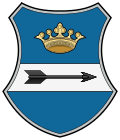Zala County (former) Last updated November 16, 2025 History Zala county arose as one of the first comitatus
In 1850, shortly after the 1848 revolutions , the mostly Croatian-speaking area between the Mur and Drava rivers – the Međimurje region (Hungarian : Muraköz German : Murinsel lit. ' Mur island ' ) – was transferred to the Habsburg Kingdom of Croatia ; [ 1] it was returned to Zala in 1860 and remained until 1918.
The formation of modern Zala County. (1) and (2) territories assigned from Zala County to Veszprém County in 1950. (2) territory reincorporated into Zala County in 1978. (3) territory assigned from Somogy County to Zala County in 1950. (4) territory assigned from Vas County to Zala County in 1950. In 1920, by the Treaty of Trianon , the south-west of the county (the Međimurje region and southeastern parts of Prekmurje (Hungarian : Muravidék Kingdom of Serbs, Croats and Slovenes (from 1929 as Yugoslavia). The award recognised the 1918 occupation of Međimurje and 1919 occupation of Prekmurje . [ 2] The remainder stayed in Hungary. The Yugoslavian part was occupied and annexed again by Hungary between 1941 and 1945 during World War II . In 1950, as part of the Communist reforms of local government, the county's borders were re-drawn again. A small part of former Vas county, north of Zalaegerszeg, went to Zala County . The part of Zala county north of Lake Balaton went to Veszprém County .
Since 1991, when Slovenia and Croatia became independent from Yugoslavia , most of Međimurje is part of Croatia (mostly in Međimurje County ; Legrad is in Koprivnica-Križevci County ); Razkrižje , Globoka and Prekmurje (the area around Lendava ) is in Slovenia.
Demographics In 1900, the county had a population of 437,116 people and was composed of the following linguistic communities: [ 3]
Total:
According to the census of 1900, the county was composed of the following religious communities: [ 4]
Total:
In 1910, the county had a population of 466,333 people and was composed of the following linguistic communities: [ 5]
Ethnic map of the county with data of the 1910 census (see the key in the description). Total:
According to the census of 1910, the county was composed of the following religious communities: [ 6]
Total:
Subdivisions In the early 20th century, the subdivisions of Zala county were:
Today, the towns of Prelog and Čakovec are in Croatia ; Lendava is in Slovenia .
Earlier subdivisions In the early 19th century Zala County was divided into: [ 7]
Processus Lövőensis Zalalövő )Processus Insulanus Međimurje / Muraköz Processus Egerszegiensis Processus Kapornakiensis Nagykapornak )Processus Szántóiensis Processus Tapoltzensis In 1854 Zala county (which at that time excluded Međimurje / Muraköz Stuhlbezirke [ 8]
Bánok-Sz.-György Pácsa Keszthely Tapolcza Sümegh Kanizsa Lendva Zala-Egerszegh References ↑ Gesetz vom 12. Juni 1850, RGBl. 245/1850: "Verordnung des Ministeriums des Innern vom 12. Juni 1850, betreffend die Organisirung der politischen Verwaltungsbehörden im Königreiche Croatien und Slavonien" . Reichs-Gesetz-Blatt für das Kaiserthum Österreich (in German). 12 June 1850. Retrieved 4 September 2023 – via ÖNB-ALEX - Historische Rechts- und Gesetztexte Online. ↑ Vuk, Ivan (2019). "Pripojenje Međimurja Kraljevstvu Srba, Hrvata i Slovenaca: Od neuspjeloga pokušaja 13. studenog do uspješnoga zaposjedanja Međimurja 24. prosinca 1918. godine" [ The Annexation of Međimurje to the Kingdom of Serbs, Croats and Slovenes: From the unsuccessful attempt on 13 November to the successful occupation of Međimurje on 24 December 1918] . Časopis za suvremenu povijest (in Croatian). 51 (2). Zagreb: Croatian Institute of History: 520– 527. doi : 10.22586/csp.v51i2.8927 . ISSN 0590-9597 . ↑ "KlimoTheca :: Könyvtár" . Kt.lib.pte.hu. Retrieved 6 December 2012 . ↑ "KlimoTheca :: Könyvtár" . Kt.lib.pte.hu. Archived from the original on 21 February 2014. Retrieved 6 December 2012 . ↑ "KlimoTheca :: Könyvtár" . Kt.lib.pte.hu. Retrieved 6 December 2012 . ↑ "KlimoTheca :: Könyvtár" . Kt.lib.pte.hu. Archived from the original on 21 February 2014. Retrieved 6 December 2012 . ↑ Lipszky, Janos; Gottfried, Prixner; Karacs, Ferenc (1808). "Mappa Generalis Regni Hungariae" . David Rumsey Map Collection . Pesthini. Retrieved 5 September 2023 . ↑ Gesetz vom 6. April 1854, RGBl. 80/1854: "Verordnung der Ministerien des Inneren, der Justiz und der Finanzen vom 6. April 1854 betreffend die politische und gerichtliche Oraganisierung des Königreichs Ungarn" . ÖNB-ALEX - Historische Rechts- und Gesetztexte Online (in German). 6 April 1854. Retrieved 5 September 2023 .
This page is based on this
Wikipedia article Text is available under the
CC BY-SA 4.0 license; additional terms may apply.
Images, videos and audio are available under their respective licenses.





